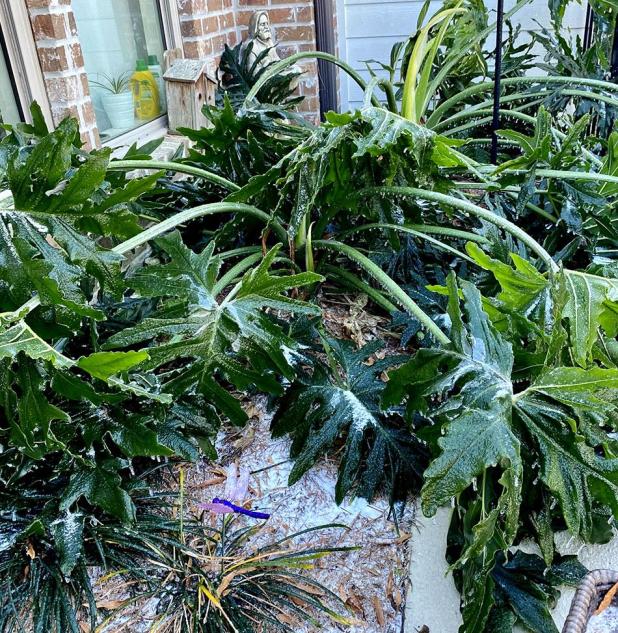
Sensitive plants such as tropical plants will suffer from freezing temperatures. Wait to prune until the spring when all danger of freezing has passed.
—LSU AgCenter/Heather Kirk-Ballard
Get It Growing: Garden tips for after a freeze
Put down the pruning shears.
With freezing temperatures across Louisiana and a dose of ice, sleet and even snow in some places, all of our gardens probably have suffered some damage. It’s tempting to rush outside to prune away unsightly damaged sections or even rip out entire plants — but you will have better results in the long run if you just wait.
Give plants time to recover. What seems to be dead now may show new signs of life later. And remember that winter isn’t over yet. We could still have more freezes — and more freeze damage.
Spring will be here soon enough. That will be the best time to prune plants that need a little help and remove those that didn’t pull through.
In the meantime, you can begin assessing the extent of damage in your landscape. Start thinking about what will need attention in the spring and coming up with ideas for possible replacements. Also take note of which plants have demonstrated resilience to the freeze. You may want to incorporate more of these hardy plants into your garden to enhance its overall robustness.
Because some of us will inevitably end up needing to plant new plants this spring, let’s take a minute to talk about making selections that are better suited to challenging weather conditions.
Much of the freeze damage you are seeing now is likely on what we call tender plants — those that die in freezing winter temperatures. In mild winters like we often have in Louisiana, these plants are often able to survive. But because the severity of our winters can vary — as we recently saw — they are at risk in other years. Herbaceous, tropical and subtropical plants fall into this category.
Plants that are hardy are those that can survive our typical winter temperatures without having to be protected. Most trees and shrubs and other woody plants are reliably hardy in freezing temperatures and do not typically suffer from low temperatures. Most perennials are root hardy, meaning they will die back but will return from their roots, crown or other underground parts such as bulbs or tubers.
In Louisiana, we are fortunate to be able to grow a wide variety of plants. When choosing new additions for the landscape, we tend to think about heat tolerance in the summer. Don’t forget to take cold hardiness into account as well.
Use the USDA hardiness zone maps to help you decide which plants will perform best for your landscape. A plant is considered hardy if it can tolerate lower temperatures than your area would typically receive.
It’s not a bad idea to choose plants that are hardy at least one zone north of where you garden. That way, should an unusually cold winter occur, your plants could endure it. So when selecting cold-hardy plants for a landscape in Zone 9, make sure they are hardy to Zone 8. If you live in Zone 8, choose plants that are hardy to Zone 7.
Cultivating plants that are not well suited to your region’s climate may be feasible at times if you leverage the concept of microclimates. A microclimate refers to a specific area on a property where the climate deviates from the overall climate of that property. For instance, a location adjacent to the south-facing wall of a house is typically warmer than other areas in the yard. With this knowledge, you could successfully grow a plant in that specific microclimate even if it might be considered somewhat delicate for the region.
Now, let’s get back to what we should — and should not — be doing in our gardens during the remainder of winter.
Ensure your plants are well hydrated. Water dry soil to provide essential moisture, which also helps insulate roots. However, avoid overwatering. Waterlogged soil can lead to root rot. Many plants are dormant or slow growing in winter months and do not require nearly as much water.
If you haven’t already, apply a layer of mulch around the base of plants to insulate the soil and retain moisture. Mulching helps prevent rapid temperature fluctuations in the soil, offering a protective buffer against further stress.
If you can’t stand the sight of damaged and dead foliage and branches, be sure to trim them away with sharp, clean pruning shears. Again, we recommend waiting till the spring to cut back to healthy, living tissue. Why? Pruning will encourage the plant to redirect resources to its viable parts and stimulate new growth. New, tender growth will be sensitive to low temperatures yet to come this winter, leaving your plant susceptible to further damage.
Hold off on fertilizing too. Wait until the growing season resumes and signs of recovery are evident. Premature fertilization can stress the plant, hindering its ability to bounce back.
You can bring life back into your garden after a hard freeze. Remember, a thoughtful and patient approach is the key to restoring your landscape.
